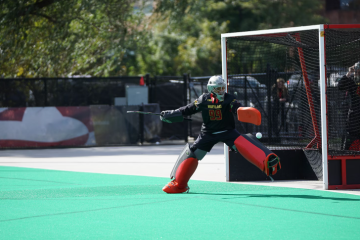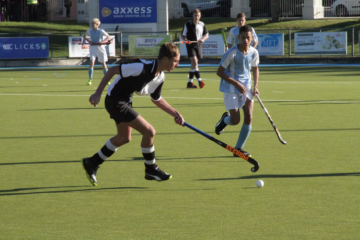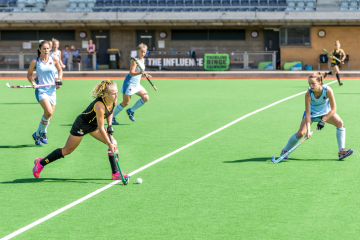Field hockey is a fast-paced team sport that requires each player to understand their unique position and role on the field. With 11 players on each side, the various field hockey positions work together to advance the ball, defend their goal, and score. This article will provide an overview of the key field hockey positions and their responsibilities during match play.
Forwards
The forwards are offensive players responsible for advancing the ball up the field towards the opponent’s goal using skills like dribbling, passing, and shooting. There are five forwards in field hockey – three in the front row and two on the sides.
The three forwards in the front row are called inner forwards or inners. The inners attack the goal by positioning themselves in front of the striking circle. Their key role is to score goals, so they need excellent ball control, dribbling skills, and shooting accuracy. The two forwards on the sides are called wingers or wings. Wings stay wide to stretch out the defense and cross the ball to the inners for scoring chances. Wings rely on speed, stamina, and passing skills to move the ball upfield.
| Field Hockey Forward Positions | Key Attributes |
|---|---|
| Inner Forwards | Ball control, dribbling, shooting accuracy |
| Wingers | Speed, stamina, passing skills |
| Center Forward | Strength, finishing ability |
| Striker | Agility, positioning, scoring |
Forwards apply constant offensive pressure as they attack the goal. Their specialized skills are crucial for advancing the ball into scoring position.
Midfielders
The midfielders connect the defensive players and forwards. There are usually four to five midfielders who transition the ball from defense to attack. Midfielders are all-around players who must be fit, skilled in dribbling/passing, and able to support both offense and defense.
There are two central midfielders at the heart of the team who distribute the ball laterally and vertically up the field. They provide a vital link between the defenders and forwards. On the flanks are two wing halves who play both offense and defense. Wing halves have a large area of the field to cover as they shuffle from helping defenders to joining the attack. Finally, some teams have a specialist center half position. Center halves initiate attacks once their team gains possession. They need excellent vision to see passing channels upfield.
Midfielders must be well-rounded athletes with the endurance to box-to-box up and down the field. Their balanced skill set allows them to transition between attacking and defending.
Defenders
The defenders prevent offensive opportunities for the opponent and regain possession. There are usually four to five defenders who remain behind the midfield line. Defenders require physical strength, tackling skills, and communication abilities.
Central defenders mark the opposing forwards and try to dispossess them before they can take a shot. They need to read plays quickly and coordinate with the other defenders. Side defenders, or full backs, cover the wings and wide areas of the field. They work to force the ball inside towards the other defenders and midfield support. Finally, the goalkeeper defends the goal itself. The goalie’s primary role is stopping shots, so they wear extensive protective gear. Goalies need quick reflexes, agility, and courage to defend the goal.
Defenders employ a mix of physicality, positioning, and teamwork to prevent scoring opportunities. Their pressure and tackling force turnovers to transition the ball back to their offense.
Penalty Corners and Specialists
Penalty corners are prime scoring opportunities that require specialized placements and skills. For a penalty corner, five players arrange around the goal to try a preset play that creates a shot on goal.
The injector starts the play by pushing the ball to one of the offensive players. The stopper is positioned to receive the injector’s pass and create the initial shot opportunity. At the goal post is the specialist hitter who has the optimal shooting angle for slamming the ball into the net. Nearby is the distributor who may receive a pass before passing to the hitter. Finally, the fifth player is the lurker who positions themselves for any rebound opportunities off the goalie’s initial save.
Teams carefully plan their penalty corner lineup and routines to maximize the chance of converting these golden scoring chances into goals. Each position has a specific role in quickly creating an open look on goal.
All in all, field hockey is a complex sport that relies on each player’s understanding of their position’s duties. Forwards apply constant offensive pressure to move the ball upfield into scoring position. Midfielders transition the ball between attack and defense with their well-rounded skills. Defenders prevent scoring chances and force turnovers to regain possession. On penalty corners, specialized players use precise teamwork to create the best opportunity to score. With 11 positions working together, field hockey teams combine fitness, field vision, communication, and both individual and collaborative skills to achieve victory.



0 Comments